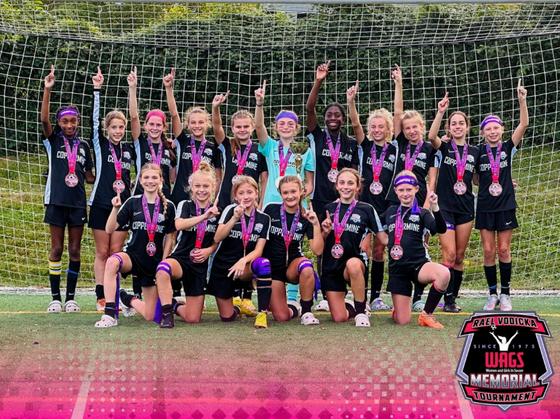




























Before the start of the Spring 1977 season, I was elected to the position of WAGS President.
As mentioned in the last article, I was elected in the middle of the seasonal year per Rael’s request, so that I could learn the ropes and build a relationship with the FCSA (later to become the NCSL).
My first official year as President of WAGS was the Fall 1977-Spring 1978 season. Alongside me were the other elected officials for the seasonal year: Barbara Walden (Secretary), Mavis Derflinger (Treasurer), Committee Chairs, Jackie Reed (Rules and Discipline Chairman) and Steve Smellowsky (Scorekeeper).
WAGS Fall 1977 Season Clubs: Annandale, Bladensburg, Bowie, Braddock Road, Columbia, Fairfax Police, Great Falls, Lee Mt. Vernon, Little River, McLean, Reston, Santos, South Bowie, Southwest Youth, Springfield, Vienna, and Wheaton.
With a total of 17 clubs and 57 teams across two states, WAGS now had competition in every age group. The 1963 group was so packed, it went on to have an A and B division. It was a great start to my presidential year, and the upward momentum did not stop there.
At the start of the Fall 1977 seasonal year, Mavis Derflinger and I took on the position of League Registrars. It was our responsibility to manage the number of registered teams and supervise all incoming data from every club. As WAGS grew, I expanded the Registrar pipeline. I appointed a Head Registrar for both Virginia and Maryland, with additional registrars working underneath them each with their own assigned clubs.
 Adele Dolansky
Adele Dolansky
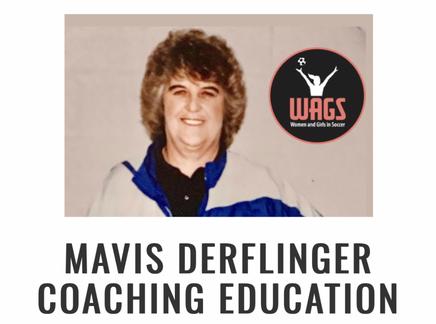




New Jersey Youth Soccer and WAGS recently hosted the in-person week for an All-Female National C License Course, which consisted of two full days and two half-days of small group activities and individual field work. Coach candidates from 11 different states across the country are participating in this year’s course.

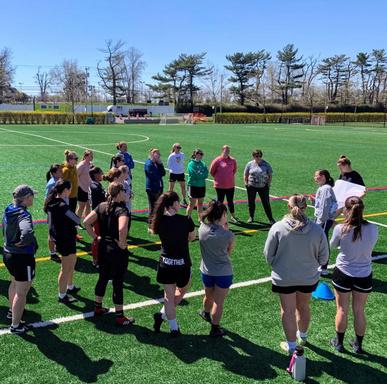

WAGS brought 10 guests to celebrate Jill Ellis' induction into the Virginia Hall of Fame on March 20th. Jill made time to remember her roots thanked all those that help make youth soccer possible and highlighted her playing days in WAGS amongst a few other memories! WAGS’ Lula Bauer, Marie Schweitzer, and Kerry Diederich are pictured with Jill. Also pictured with Jill is Michelle Dolansky, Maria Ramos and Andy Onorato.We are very proud to call her a WAGS alumni!



The Virginia Sports Hall of Fame is a non-profit resource celebrating athletic excellence in the Commonwealth of Virginia. Highlighting philanthropy through sports, we aim to inspire sports fans through programming and engaging entertainment.
Jill Ellis’ Story
$40,000 Anually
Our 2024 WAGS Adele Dolansky Scholarship recipients are featured below. We received very impressive submissions for our scholarship committee to review. The 2025 application link will open in October 2024


Elizabeth Sielski played for Fredericksburg FC U19 Girls Black and will attend and play for Georgia Southwestern State University in the fall
Eleanor Martin played for Richmond Strikers RL G06-05 Elite 1 and will attend and play for Bates College in the fall
Erin Cliff played for TSJ FC Virginia 05/06G and will attend and play for Rhodes College in the fall.
Riley Dobranski played for Richmond Strikers RL G06-05 Elite 1 and will attend and play for Roanoke College in the fall.

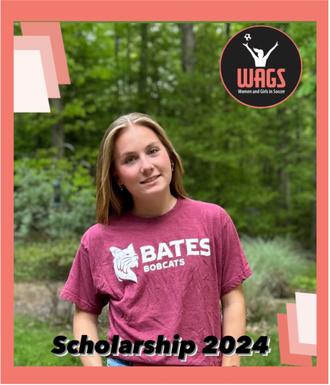


Scholarship Amounts
Grant Scholarship amounts of up to $1,200 each

Women and Girls in Soccer has announced the first-of-its-kind WAGS
Grant Requirements
Licensed Coach
Actively coaching a team
Rostered active SemiPro player
Need Based
Childcare Grant Application

Childcare Grant; an $80,000 fund to be distributed to individual female coaches, semi-pro players and female referees to help them stay in the game.


In the realm of sports, the physical aspect often takes center stage, with training regimens, nutrition plans, and skill development dominating the conversation. However, the mental aspect of athletic performance is equally, if not more crucial, especially for teenage female athletes navigating the complexities of adolescence alongside their sporting pursuits.
The Champion’s Mindset (TCM) has emerged as a valuable tool for enhancing performance, building resilience, and promoting holistic well-being. Our group of female athletes, ages 12-16, meets virtually three Sunday’s a month for 6 months. Each session involves an hour of mental fitness work, engaging discussion of real life challenges, and relationship building.
There is no doubt that the teenage years are a pivotal time marked by significant physical, emotional, and social changes. For young female athletes, these changes can be particularly pronounced as they balance the demands of school, sports, and personal development. Amidst this juggling act, The Champion’s Mindset provides a structured framework for cultivating mental skills essential for success both on and off the field.
One of the primary objectives is to foster a growth mindset an attitude that thrives on challenges, sees failures as opportunities for growth, and believes in the power of effort and perseverance. By instilling this mindset early on, athletes are better equipped to navigate setbacks, bounce back from defeats, and maintain a positive outlook amidst adversity.
In addition, our Champions learn the importance of goal setting, imagery, and self-talk in enhancing performance and building confidence. Imagery techniques are underutilized and undervalued within today’s youth athletics. Imagery enables athletes to mentally rehearse their performances, enhancing their sense of preparedness and confidence when it comes time to compete. Similarly, positive self-talk serves as a powerful tool for overcoming self-doubt and quieting the inner critic, allowing athletes to harness their inner strength and perform at their best when it matters most.
Beyond the realm of performance enhancement, The Champion’s Mindset also addresses the broader psychosocial needs of teenage female athletes, including stress management, coping strategies, and self-care practices. In an era where mental health issues among adolescents are on the rise, cultivating resilience and emotional well-being is paramount. By providing a supportive environment where athletes can openly discuss their struggles, learn coping strategies, and develop healthy habits for managing stress, TCM plays a vital role in safeguarding the mental health of young athletes.
Each Sunday, TCM creates a space where these athletes can connect with peers who share similar goals and experiences. This sense of camaraderie not only enhances motivation and accountability but also serves as a source of encouragement and support during challenging times.
The effectiveness of TCM is evident in the tangible outcomes it yields. The Champions report greater resilience, improved confidence, enhanced focus, and a more positive attitude towards challenges. They are better equipped to manage stress, navigate setbacks, and maintain a healthy balance between their athletic pursuits and other aspects of their lives. Most importantly, TCM lays the foundation for lifelong skills that extend far beyond the realm of sports, empowering the Champions to excel in any endeavor they pursue.
As their coach and leader, it has been an incredibly rewarding journey to see and feel the growth. The fulfillment is overflowing -- and I know my 14-year old self would have been a happier and healthy human if she had a program like this.
With the support of organizations like WAGS and the Washington Spirit, The Champion’s Mindset will impact hundreds of athletes across the country for years to come. If you are interested in signing up for the next cohort, email lohman.joanna@gmail.com and/or apply HERE.
WAGS is a proud sponsor.



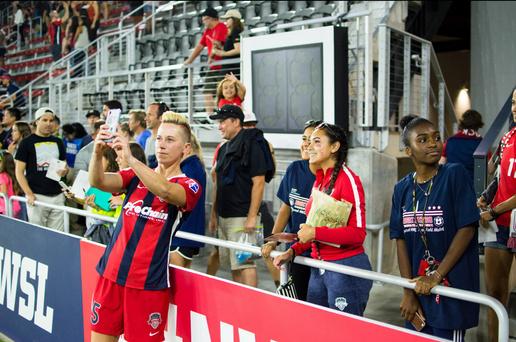

WAGS would like to honor the many women who have continued to follow their love for the beautiful game. Whether you played in the WAGS Tournament growing up, or are looking for a new chance to compete, we are proud to be offering the WAGS Legacy Division for the third year during our 2024 WAGS Tournament!

Presented by WAGS the Rael Vodicka Tournament is one of the top all girls events in the nation. Since 1975, this annual tournament brings teams from all across the United States and Canada to play in U9 to U19 brackets. There will be National, Regional, and State Champions in attendance!

from page 3
After the Spring 1980 season, I successfully lobbied to update league by-laws, adding a Vice President to our list of officers. Bruce Cunningham from Alexandria served as WAGS first Vice President. Other elected officers for the season included Linda Schultz (Secretary), Linda Van Landuyt (Treasurer).
In the following season, I further expanded administration by lobbying for the roles of Vice President of Virginia and Maryland, respectively. I also updated the by-laws to include another new role: the Director of Rules & Discipline. The first Vice President of Virginia teams was Bruce Cunningham, and the first Vice President of Maryland teams was John Absalom. Don McElhone was elected Director of Rules and Discipline.
Much of this league growth came from my lobbying, but I could not have done as much as I did without Mavis Derflinger, who was by my side for the 1979-1980 seasonal year. Although she stepped down from her position as WAGS Treasurer, she moved on to become Vice President (and later President) of VMYSA. Her star only grew from there, as she was later elected Region I Sub-Regional Commissioner in 1981, soon to become USYSA Region I Commissioner. She served as USYSA Chairperson up into 1990. Mavis rose up in the ranks of US Youth Soccer, but I believe her heart always remained with WAGS, and the Girls Soccer Program. Without her help, and hard work, WAGS would not be where it is today. In my mind, she is forever the league’s Champion.
WAGS and the NCSL (formerly known as FCSA) continued to schedule together, with meetings now being held at my home instead of Rael’s. Board members from both leagues came together in the basement of my house, drinking coffee and working together to finalize dates, times, and locations for club games.
Now, this process was a large one, and writing an entirely separate article about it would be warranted. But to keep it short, scheduling meetings were like a big game of bingo.
A board member would be assigned at least two age groups and would have about four sheets of schedules in front of them. Each board member was given coins usually pennies. We would begin naming clubs in alphabetical order, and the board members would look between their two age groups to see if they had a team scheduled for home. If they did, they would call out, and from there it was discussed which fields would be open for those home days, which coaches would be available, and which teams would play. When all was scheduled, the penny would be placed on the sheet, and the date and time would be marked on a master paper hanging on the wall.
We didn’t have the luxury of computers to put all this data together, so we had to work hard to solve this gigantic puzzle a challenge which would typically last the entire day. I would serve donuts for breakfast, and barbeque for dinner. If the meetings dragged on into the morning, I’d provide the coffee, and we’d finish scheduling sometime around noon.
When the initial puzzle was completed, and the board members went home, NCSL Administrator Joanne Palmer and I would cross reference and triple-check every aspect of the process. We kept the field loading logs and would compare and correct any mistakes made during the scheduling meeting. If there were scheduling requests, we did our best to honor them. I would then make a master field log to give to the Maryland and Virginia Referee Assigners.
Years later, we made the process digital, and utilized scheduling software under management of Demosphere. The program blueprint was originally created by Don McElhone, and was then enhanced by my son, Mark Dolansky. It was handed over to Demosphere to become the base for WAGS and NCSL scheduling.
The digital process came with its own quirks. When Joanne Palmer retired as NCSL Administrator, I worked with her successor, Kathleen Sessions. Kathleen and I provided Demosphere with our list of teams, and our overall division structure. Demosphere would then sort each list according to the structure, and then send it back to me. I received Kathleen’s NCSL scheduling requests, received field information from clubs including field start times, closing times, inactive dates and so on. I fixed any mistakes in the program by hand. This was the first phase of the new scheduling process, which became something I lovingly called “prepping the Matrix.”
The second phase consisted of putting games on the fields per the club’s restrictions and dealing with any scheduling conflicts. I had to take travel time into account, so that coaches with more than one team would have time between games to get to where they needed to go. I made sure coaches who had specific scheduling requests had them granted. This all took a lot of time. I was thankful to have a husband who could cook, and who didn’t mind that I was in the basement office 24/7 working on what I called a “giant puzzle.”
When I was done, I would call Kathleen, and she would pick up the scheduling disk from my house. We’d then get to work again, printing out the information and distributing it at our league meetings. I was always involved in the scheduling process and continued to work on scheduling until my own retirement, the end of the Fall 1977 season.
Around the 1980-1981 seasonal year, I went to battle against both the Maryland and Virginia State Associations regarding three important issues. These battles not only went on to elevate Girls’ Soccer to the same level of Boys’ Soccer, but they also changed the game when it came to how soccer itself was run in local high schools.
The first battle was with the Maryland Youth State Association.
Back then, Maryland had a state cup for boys, but not for girls. Although I lobbied for Maryland to start having state cup competitions for girls, I was rejected by their state president. After that denial, I decided to attend one of their meetings, and I petitioned the request in front of the Maryland board. I told them that the girls could play just as well as the boys could—if not better— if they were just given the chance.
When the state president started to come up with excuses, I shut him down at each turn. He said there was no one to run a state cup for girls, so I said to him: “Let me introduce you to Linda Schultz, a Maryland Club Rep and Registrar and the WAGS Secretary she will run the Maryland Girls State Cup Competition for you.”
After this meeting, Maryland began to have state cup competitions for girls, with Linda Schultz becoming the first Maryland Girls State Cup Chair. She would then move on to become the MSYSA State President.
The second and third battles were with the Virginia Youth State Association.
In Virginia, high school leagues play their soccer in the spring. This was still the case back in the 80’s, although back then there was a rule that stated that you could not play club and high school soccer together at the same time. For those who didn’t make the high school team, players had no options to continue playing soccer in the spring, since there were not enough available players to field their club. Therefore, in the fall of 1979, I pushed a petition with the State Association to allow WAGS the use of a provisional roster, figuring that it could be used for teams within the same club, or if two clubs had the same problem.
Although I received opposition from some VMYSA board members especially the state registrar a petition was filed and eventually approved by the VMYSA Board with thanks to then State President, Mavis Derflinger. With that, the WAGS provisional roster was born.
Despite popular belief, female soccer players did not “grow out” of the sport they loved. Back then, a lot of people thought that girls would just get bored and quit sports as they grew older. But from the very beginning, WAGS had players dedicated not only to the league itself, but to the game of soccer. These women did whatever it took to prove that Girls’ Soccer was here to stay, and fought tooth and nail for the respect they were due.
WAGS was built not only by the pioneers within the league, but the players who represented it. If not for our dedicated players, girls would have struggled to find fields to play. They would have been stuck with secondhand, dirty jerseys and unqualified referees to call their games. WAGS itself was able to elevate girls’ soccer as a sport, and in turn, elevate the talented, hardworking women who would go on to represent their sport at a national level. WAGS Alumni permeate throughout the United States, some becoming professional players, others becoming college coaches, or even members of the Women’s National Team, and or a Coach of a National Team.
This dream that Rael, Mavis, and I shared together—of girls’ soccer blossoming—was able to create a league that changed the history of women’s soccer in America. I am forever honored to have been a part of that process.
In 1980, Rael Vodicka and Carmen Kelly passed away.
The WAGS League Board of Directors voted to change the name of their tournament to the WAGS Rael Vodicka Memorial Tournament, in honor of its founding president. An age group perpetual trophy would be named the Carmen Kelly Trophy, in honor of one of its founding members.
Throughout the 1980’s and into the 1990’s, the WAGS Tournament would only grow in prestige. WAGS’ impact on women’s soccer grew with each passing year, with tournaments drawing in more and more hungry players from all over North America…
Along with this battle, another was being waged with the Virginia State Association. Although there were State Select teams for boys AND girls, the girls could not compete until the boys completed their competitions. The girls also did not have their own uniforms, and were forced to accept hand-me-down jerseys from the boys. When this was brought to my attention, I attended every board meeting, singing the same song: the girls were entitled to have their own uniforms. Soon after I began this campaign, miraculously, money was found in the State budget to buy new uniforms for the State Select girls.
Stay Tuned for the Next Chapter: Country-Wide Connections! How the WAGS Tournament spread across North America, and how the league changed the game of women’s soccer up to an Olympic level…

Our Mission is to empower Women to reach their goals in soccer. We strive to elevate and make women feel valued. Our WAGS Tournament has been serving women since 1975 and is our only funding source that makes it all possible.



We’d love to hear from

